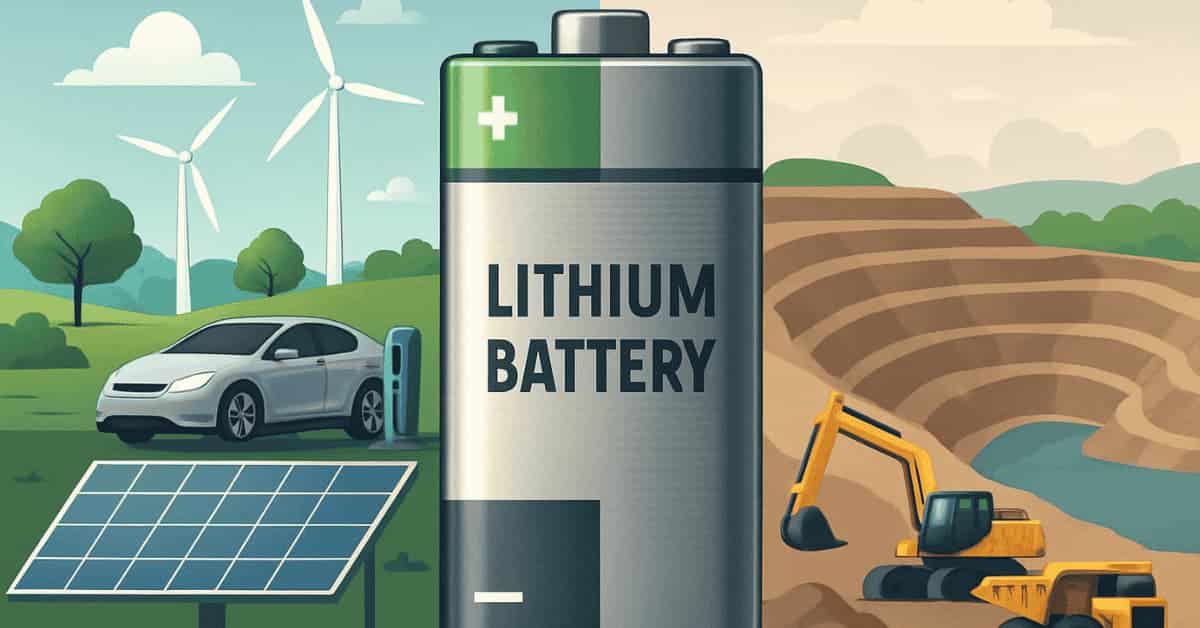We use batteries every day. Our electric cars, computers, and phones are all powered by them. These are often lithium batteries. They contribute to our reduced reliance on fossil fuels, which benefits the environment.
But lithium batteries also have environmental problems. Making them can hurt the planet.
This guide will examine whether lithium batteries are bad for the environment. We will follow their journey, including getting and throwing away the materials. You will learn about their true impact. We will also discuss what you can do to help.
The Environmental Impact Of Lithium Mining
When we discuss lithium batteries and their impact on the environment, we must first consider where lithium comes from. Lithium doesn’t magically appear in our devices. Lithium comes from the earth. We get it through mining. This mining really hurts the environment.
1. How We Get Lithium
There are two main ways we extract lithium today:
a. Getting Lithium from Saltwater (Brine Mining)
Saltwater is the source of almost two-thirds of the lithium found worldwide. We pump mineral-rich saltwater from underground into big ponds. The sun dries the water over many months, leaving concentrated lithium behind. Then, we process this lithium to make it useful.
b. Getting Lithium from Rock (Hard-Rock Mining)
Lithium is also found in solid rock, particularly in the mineral spodumene. An old mining method involves digging up rocks, crushing them, and then separating the valuable lithium.
When I visited the Atacama Desert in Chile, a huge lithium-producing area, I saw many evaporation ponds. From above, the bright blue ponds looked nice. But they actually show a difficult environmental problem.
2. Water Concerns: A Thirsty Business
Lithium mining uses a lot of water. This is a big worry for the environment.
Look at these numbers:
- It takes roughly 500,000 liters of water to produce one ton of lithium.
- We get about one ton of lithium for every 2.2 million liters of water.
This causes serious water shortages in dry places like Chile’s Atacama Desert.
People who live near lithium mines often say that the water levels underground are dropping. They also report that their farms are not producing as much food.
In some areas, farmers and local communities have to share limited water with mining companies.
3. Land Damage and Nature’s Upset
Lithium mining does more than just use a lot of water. It also changes the land and harms nature.
- Big holes are dug in the ground to extract hard-rock lithium, leaving huge marks on the land.
- Roads and buildings built for mining break up natural areas where animals live.
- Ponds used to dry out water for lithium extraction change the flow of water in the area, which can harm wildlife.
- Chemicals used to process lithium can pollute the soil.
You might not see these problems when you use your devices, but they are very real for the people and nature in places where lithium is mined.
4. Digging for Lithium: A Carbon Problem
Lithium batteries help reduce carbon pollution when used, but making them creates a lot of greenhouse gases.
- Digging up one ton of lithium creates about 15 tons of carbon dioxide (CO2) pollution.
- Getting lithium from salty water (called “brine extraction”) releases up to 2.8 tons of CO2 for every ton of lithium.
- Digging for lithium in hard rock creates even more pollution. Every ton of lithium produces up to 17.1 tons of CO2.
The demand for lithium is growing fast. Experts think it will increase by 25-26% each year until 2030. This makes pollution from lithium mining a big problem for our climate goals.
5. Global Hotspots: Where Your Battery Begins
Most of the world’s lithium, nearly 90%, comes from just a few places:
- Australia (They dig it out of hard rock.)
- Chile (They get it from salty water.)
- Argentina (They also get it from salty water.)
- China (They use different ways to get it.)
In 2023, the world produced about 170,800 tons of lithium. These countries were the main producers. Each area has its own environmental problems, which depend on the local nature, how much water is available, and how the lithium is obtained.
What Can We Do?
You can’t directly change how companies mine lithium. However, your choices when buying things and speaking up can help. Support companies that get their materials responsibly. Also, push for stronger environmental rules in mining areas. These are important steps we can all take.
Manufacturing Process And Carbon Footprint
After lithium is extracted from the earth, it goes through several energy-intensive manufacturing processes before becoming the battery in your device. Let’s look at what happens during this crucial phase and how it affects our environment.
1. From Raw Material To Battery Cell
Making a battery from raw lithium takes a lot of energy. Here’s how it works:
- First, we turn raw lithium into lithium carbonate or lithium hydroxide.
- Next, we create the materials for the positive and negative parts of the battery using chemical processes.
- Then, we put together individual battery cells with separators and liquids that help electricity flow.
- Finally, these cells are then assembled into larger modules and battery packs.
Every step uses a lot of energy and materials. Last year, I visited a battery factory. The precise work there impressed me.
However, I am also worried about the environmental impact of such a large operation.
2. Energy Consumption And Emissions
Batteries manufacturing uses a lot of energy.
- The 1,100-pound EV battery produces more than 70% more CO2 than a typical automobile.
- Making cathodes requires high heat, which uses a lot of electricity.
- If fossil fuels create this electricity, it greatly increases carbon pollution.
- Producing a typical lithium-ion battery creates 150-200 kg of CO2 for every kilowatt-hour of battery power.
- For example, a standard 75 kWh electric car battery might create 11-15 tons of CO2. This happens before it ever powers a car.
3. Chemical Usage And Pollution Risks
Making batteries uses several harmful chemicals. These include:
- Poisonous liquids: We use these when making battery parts.
- Strong acids: These help process materials.
- Heavy metals: Examples are cobalt and nickel. They can harm the environment if not handled properly.
We must carefully manage these chemicals. This stops them from polluting our air and water.
Sadly, rules for making batteries are different around the world. Some places have strong environmental rules. Other places do not.
4. Industry Improvements
The good news is that battery manufacturers are working to reduce their environmental impact:
- Shifting to renewable energy for production facilities.
- Developing less energy-intensive manufacturing processes.
- Reducing dependence on rare and problematic materials like cobalt.
- Improving efficiency means getting more energy storage from fewer materials.
When shopping for products with lithium batteries, look for companies that are transparent about their manufacturing processes and committed to reducing environmental impacts. Some manufacturers now publish sustainability reports to help you make more informed choices.
Lithium Batteries Disposal And Recycling Challenges
What happens to lithium batteries when they end their useful life? This is where another significant environmental challenge begins.
Let’s explore the disposal issues and recycling opportunities of these energy storage workhorses.
End-of-Life Environmental Concerns
When lithium batteries are improperly disposed of, several environmental problems can occur:
- Toxic metals can leach into soil and groundwater.
- Battery fires in landfills release harmful pollutants into the air.
- Valuable materials that could be reused are wasted.
- Additional mining is required to replace these materials.
I’ve seen the aftermath of a lithium battery fire at a waste processing facility, and it’s not pretty. These fires are difficult to extinguish and release a cocktail of toxic chemicals.
Current Recycling Rates
Despite the value of materials inside lithium batteries, recycling rates remain disappointingly low:
- Only about 5% of lithium-ion batteries are currently recycled globally.
- Most consumer electronics batteries end up in landfills.
- Even EV batteries face recycling challenges due to their complex designs.
- Different battery chemistries require different recycling approaches.
The good news is that recycling rates are improving as new technologies and policies develop. Several countries are implementing extended producer responsibility laws that require manufacturers to take back and recycle batteries.
Why Recycling Lithium Batteries Is Challenging
Recycling these batteries isn’t as simple as separating paper from plastic.
- Complex construction with many different materials bonded together.
- Potential fire hazards during disassembly.
- Various battery chemistries require different processes.
- Economic challenges arise when virgin materials are cheaper than recycled ones.
Innovative Recycling Technologies
Exciting developments are happening in battery recycling:

- Water-based solutions are used in hydrometallurgical procedures to recover metals.
- Direct recycling methods that preserve cathode materials.
- Automated disassembly systems that safely separate battery components.
- Biological approaches using bacteria to extract valuable metals.
Companies like Redwood Materials, Li-Cycle, and Battery Resourcers are scaling up operations to handle the coming wave of spent EV batteries. Using these technologies, up to 95% of battery materials can be recovered for reuse.
What You Can Do With Your Old Lithium Batteries
- Never put lithium batteries in the regular trash. In many countries, this is illegal and dangerous.
- Use programs from manufacturers. Many electronics companies will take back their products for recycling.
- Find local places to drop off batteries for recycling. Many hardware stores, electronics shops, and city facilities accept batteries.
- If a battery is damaged, put it in a fireproof container, fill it with sand or kitty litter, and take it to a recycling center.
- Think about using old batteries for other things. For example, electric vehicle (EV) batteries can power homes before they are recycled.
Last year, I replaced my laptop battery. I was happy to find out that my local electronics store had a free program to take it back. It only took a few minutes to drop it off, and I knew they would recycle it correctly instead of sending it to a dump.
Good And Bad Points Of Lithium Batteries
When we discuss lithium batteries and the environment, we must consider all sides. These powerful batteries have great benefits, but they also cause environmental problems.
Let’s examine both sides to understand their real impact.
Comparing Environmental Impacts Of Battery Technologies
| Battery Type | Energy Density | Lifespan (Cycles) | Toxic Materials | Recycling Rate | Carbon Footprint |
|---|---|---|---|---|---|
| Lithium-ion | High | 500-1,500 | Moderate | Low (5-10%) | Moderate-High |
| Lead-acid | Low | 200-300 | High (lead) | High (99%) | Moderate |
| Nickel-metal hydride | Medium | 300-500 | Low | Moderate (10-15%) | Moderate |
| Alkaline (disposable) | Low | Single-use | Low | Very low (<1%) | Low per unit, high overall |
Lithium Batteries And Climate Change
We need to think about how lithium batteries help fight climate change.
- Electric cars use lithium batteries. Over time, these vehicles produce a lot less pollution than gas-powered vehicles.
- Lithium batteries store power from renewable sources like solar and wind. This helps us use more clean energy.
- Large battery systems can store energy for the grid. They reduce the need for “peaker” power plants, which harm the environment.
I switched to an electric car. My personal carbon footprint went down by about 65% in the first year, even with the impact of making the battery.
Long-Term Lithium Battery Use
Let’s look at what affects how long we can keep using lithium batteries.
- Enough Resources? We have enough lithium for many years. However, finding it in only a few places causes political and supply chain problems.
- Better Technology Coming: Battery technology is always getting better. This might mean we won’t need materials that cause problems in the future.
- Growing Demand: The environmental impact of batteries may worsen as more people desire them.
- Different Rules: Mining, making, and recycling batteries are different worldwide.
Environmental Impact Of Lithium Batteries
Are lithium batteries harmful to the environment? The answer is not a simple yes or no.
- By themselves: Yes, making and getting rid of lithium batteries significantly impacts the environment.
- For clean energy: No, they help us use renewable energy and electricity, which is good for the environment.
- Compared to other choices: It depends on how you use them. They are often the best option, even with their downsides.
Lithium batteries are not good or bad on their own. Their environmental impact depends on:
- Where do we get the materials?
- How do we make the batteries?
- How do we use them?
- How do we handle them when they are no longer useful?
We must address the environmental problems of lithium batteries while using their advantages for a cleaner energy future. Next, we will examine ways to reduce their negative effects.
Solutions And Future Ideas
Lithium batteries create some environmental problems. But the good news is that many people are working on solutions. Researchers, companies, and lawmakers are all trying to make these batteries more sustainable. Let’s look at new ideas that could help.
1. Better Ways To Get Lithium
How we get lithium from the ground is changing:
- Direct Lithium Extraction (DLE): These methods can extract more lithium (30% to 80%) and use much less water than old methods that let water evaporate.
- Geothermal brine extraction: We can extract lithium from hot, salty water found deep underground, which causes little disturbance to the land.
- Seawater extraction: Scientists are developing ways to extract lithium from the ocean, which has a lot of lithium (about 230 billion tons). This method won’t use up our fresh water.
I recently talked to a researcher. They explained that DLE technology could cut water use by as much as 90% compared to traditional evaporation ponds.
2. Other Battery Types
Scientists are exploring more than just lithium-ion batteries:
- Sodium-ion batteries: These use sodium, which is common and cheap, instead of lithium.
- Solid-state batteries: These batteries don’t have liquid parts. This makes them safer and able to store more energy.
- Iron-air batteries: These are good for storing energy for power grids. They use common materials.
- Aluminum-ion and zinc-air technologies: These show promise for certain uses.
Better Ways To Make Batteries
Making batteries is getting cleaner.
- Factories that make batteries now use renewable energy.
- They use water recycling systems. These systems use less fresh water.
- They also use a dry way to make electrodes. This avoids using harmful chemicals.
- Energy recovery systems capture and reuse wasted heat.
Companies like Tesla, CATL, and Northvolt are leading this effort. They build huge factories (gigafactories) that use these new ideas to harm the environment less.
Batteries: A Full Circle Approach
The future of batteries is about reusing them.
- Batteries are now made to be easy to disassemble when they are old, which makes recycling easier.
- “Battery passports” track the materials in batteries from start to finish.
- Standard battery sizes make it simpler to collect and process them.
- Old batteries get a “second life.” This means they are used for other things before they are recycled.

What You Can Do
As customers, we have more power than we realize:
- Support eco-friendly companies. First, check their environmental promises before you buy.
- Make your batteries last longer. Charge and store them properly.
- Recycle all your battery-powered gadgets. Join recycling programs.
- Push for tougher rules. These rules should cover mining and recycling.
- Think about sharing batteries. This is for tools and equipment you don’t use often.
- Even small steps help. For example, you can change your device settings to save battery life. These small actions, taken together, greatly reduce battery use.
Policy And Industry Changes
Bigger changes are happening with laws and in businesses:
- The EU Battery Directive demands more recycling. It also requires companies to report their carbon footprint.
- Many countries are making producers responsible for their products.
- Groups of companies are creating eco-friendly standards. They are also developing certification programs.
- Mining companies are using stricter environmental protections.
These big changes, along with new technology and customer behavior, make me hopeful that lithium batteries’ future will be much greener than their past.
Conclusion
Lithium batteries, while crucial for advancing clean energy technologies like electric vehicles and renewable energy storage, present a complex environmental dilemma. Their journey, from extraction to disposal, carries significant ecological costs.
Mining lithium from brine or hard rock is water-intensive, particularly in arid regions, and can lead to water scarcity, land degradation, and habitat disruption. The process also generates substantial carbon emissions, undermining the climate goals these batteries aim to support. Furthermore, battery manufacturing is energy-intensive and involves hazardous chemicals, posing pollution risks if not managed properly.
Despite these challenges, lithium batteries’ overall environmental impact is nuanced. When compared to fossil fuels, they offer a clear advantage in reducing operational carbon emissions. Moreover, advancements in recycling technologies, the development of alternative battery chemistries, and the implementation of stricter environmental policies offer promising pathways to mitigate their negative footprint.
Efforts are underway to improve lithium extraction methods to be less water-intensive, develop more sustainable manufacturing processes, and boost recycling rates to recover valuable materials.
Ultimately, the environmental impact of lithium batteries depends on how we source materials, manufacture them, utilize them, and manage their end-of-life.
To harness their potential for a greener future, a holistic approach is required, emphasizing responsible mining, cleaner production, increased recycling, and conscious consumer choices.







